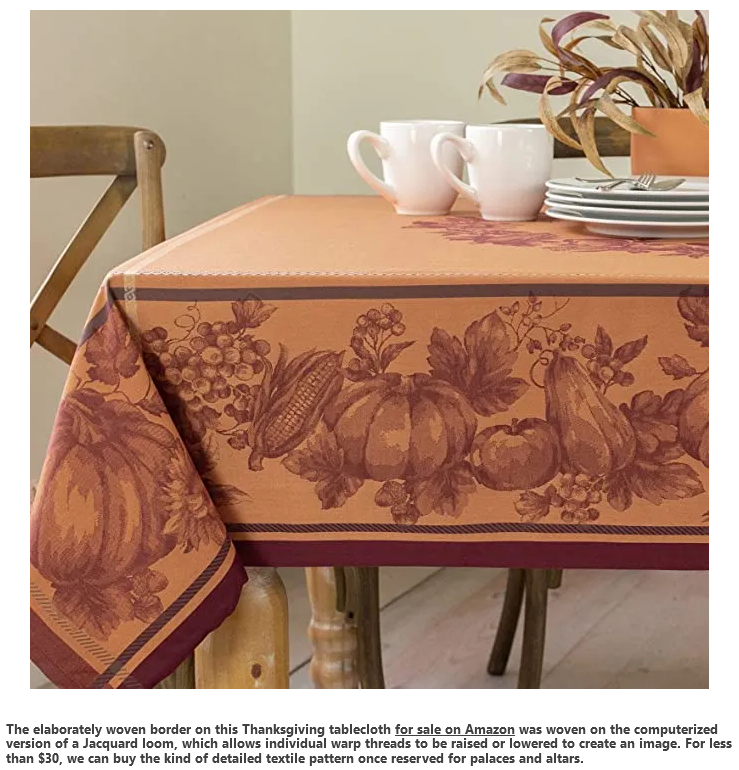Virginia Postrel wrote this originally for USA Today in 2020:
Our closets and drawers bulge with clothing in every imaginable color. Thanks to incremental improvements over the past few decades, our clothes resist stains and wrinkles in ways that would thrill the past’s laundry-weary housewives. T-shirts wick sweat, and raincoats shed water. Sweaters snap back into shape, and pants stretch with our bellies — a handy feature come Thanksgiving dinner.
Today’s textile cornucopia overflows with more than clothes. It includes the damask tablecloth beneath the Thanksgiving feast, the soft microfiber blanket in front of the fire, the potholders pulling dinner from the oven, the dish towels drying the heirloom china. Textiles upholster the dining room chairs and the football fans’ sofa cushions. They bandage the careless carver’s fingers. They furnish burlap wreaths and felt garlands, and, for those who prefer an autumnal escape to nature, backpacks, sleeping bags, and tents.
If, as Arthur C. Clarke famously observed, any sufficiently advanced technology is indistinguishable from magic, the reverse is also true. Any sufficiently familiar technology is indistinguishable from nature. We no more imagine a world without cloth than one without sunlight or rain. Textiles are just there.
Except, until fairly recently, they weren’t.
“Bring good store of clothes, and bedding with you,” an early Plymouth arrival advised a prospective colonist in 1621. Textiles weren’t easily procured in the wilds of Massachusetts. It is only in the past century, and especially in the past generation, that most Americans could forget where cloth comes from. Once so valuable they were stolen from clothes lines and passed down in wills, textile products now occupy only a tiny fraction of household budgets.
Cloth was precious because it took so much effort to make. Throughout history, and around the globe, women spent their days spinning. Yet yarn was always in short supply. In 1656, Massachusetts even passed a law requiring every family with “idle hands” — women and children who weren’t otherwise employed — to spin a minimum amount of yarn, with fines levied on those who didn’t make their quotas.
“The spinners never stand still for want of work; they always have it if they please; but weavers sometimes are idle for want of yarn,” wrote the 18th-century agronomist and travel author Arthur Young, reporting on a tour of northern England. It took about 20 spinners to keep a single weaver supplied with yarn.
A few decades after Young wrote, spinning machines broke the bottleneck and sparked the Industrial Revolution. Abundant yarn improved nearly every aspect of life. From clothing to sails, bed linens to flour sacks, essential items were suddenly much cheaper, more varied, and more easily obtained. It was the beginning of what economic historian Deirdre McCloskey calls “the Great Enrichment,” the economic takeoff that over the next two centuries lifted global living standards by 3000%.




